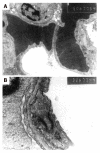Multiple pathogenic factor-induced complications of cirrhosis in rats: a new model of hepatopulmonary syndrome with intestinal endotoxemia
- PMID: 17659698
- PMCID: PMC4146787
- DOI: 10.3748/wjg.v13.i25.3500
Multiple pathogenic factor-induced complications of cirrhosis in rats: a new model of hepatopulmonary syndrome with intestinal endotoxemia
Abstract
Aim: To develop and characterize a practical model of Hepatopulmonary syndrome (HPS) in rats.
Methods: The experimental animals were randomized into five feeding groups: (1) control (fed standard diet), (2) control plus intraperitoneal injection with lipopolysaccharide (LPS), (3) cirrhosis (fed a diet of maize flour, lard, cholesterol, and alcohol plus subcutaneously injection with carbon tetrachloride (CCl(4)) oil solution), (4) cirrhosis plus LPS, and (5) cirrhosis plus glycine and LPS. The blood, liver and lung tissues of rats were sampled for analysis and characterization. Technetium 99m-labeled macroaggregated albumin (Tc99m-MAA) was used to test the dilatation of pulmonary microvasculature.
Results: Typical cirrhosis and subsequent hepato-pulmonary syndrome was observed in the cirrhosis groups after an 8 wk feeding period. In rats with cirrhosis, there were a decreased PaO(2) and PaCO(2) in arterial blood, markedly decreased arterial O(2) content, a significantly increased alveolar to arterial oxygen gradient, an increased number of bacterial translocated within mesenteric lymph node, a significant higher level of LPS and tumor necrosis factor-alpha (TNF-alpha) in plasma, and a significant greater ratio of Tc99m-MAA brain-over-lung radioactivity. After LPS administration in rats with cirrhosis, various pathological parameters got worse and pulmonary edema formed. The predisposition of glycine antagonized the effects of LPS and significantly alleviated various pathological alterations.
Conclusion: The results suggest that: (1) a characteristic rat model of HPS can be non-invasively induced by multiple pathogenic factors including high fat diet, alcohol, cholesterol and CCl(4); (2) this model can be used for study of hepatopulmonary syndrome and is clinically relevant; and (3) intestinal endotoxemia (IETM) and its accompanying cytokines, such as TNF-alpha, exert a crucial role in the pathogenesis of HPS in this model.
Figures




References
-
- Zhao LF, Han DW. Clinical significance of endotoxemia in patients with liver disease. Shijie Huaren Xiaohua Zazhi. 1999;7:391–393.
-
- Liu JC, Li RX, Yan Z, Han DW, Wang R and Ma XH. Influence of endothelin on renal function in rats with cirrhosis. Zhongguo Binglishengli Zazhi. 1998;14:717–719.
-
- Wang R, Han DW, Liu JC, Zhao YC. Studies on the pathogenesis of renal insufficiency in acute hepatic failure. Zhongguo Binglishengli Zazhi. 1999;7:482–486.
-
- Wang R, Yin L, Han DW, Liu JC, Li CM, Li Y. The dynamic changes of renal LTC4 in acute hepatic failure. Zhongguo Binglishengli Zazhi. 1998;14:720–722.
Publication types
MeSH terms
Substances
Grants and funding
LinkOut - more resources
Full Text Sources

